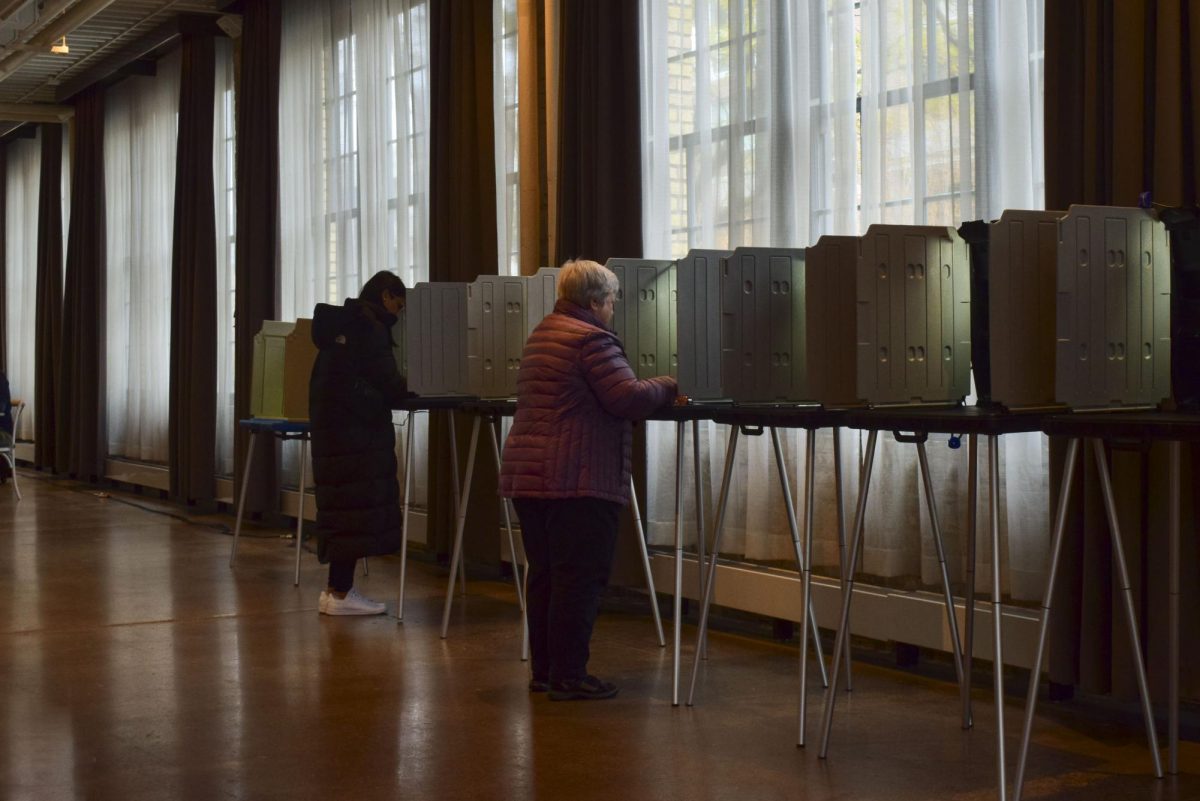Elizabeth Frost told her patient at La Clinica to go to the emergency room three times. His heart condition was serious, but the patient, an undocumented immigrant, was afraid of being deported. In the end, a visit to Regions Hospital was unavoidable. The patient underwent a quadruple bypass, but the procedure came too late. He died three weeks after FrostâÄôs initial warning. The paralyzing fear of being deported is a dangerous deterrent for uninsured, undocumented immigrants in Minnesota. The overall population of uninsured in Minnesota has increased by more than 100,000 since 2007, with immigrants twice as likely to be uninsured than the general population, according to data released by the Minnesota Department of Health on Friday. For undocumented people and documented immigrants who have been in the United States for less than five years, affording private insurance is often impossible. They are also ineligible for government-subsidized health insurance like Medicare or General Assistance Medical Care. Doctors say something needs to change. But public policy experts like Center for Immigration Studies Research Director Steven Camarota say the change will have to come though a far more complicated path: immigration reform, which Camarota said politicians want to touch âÄúas much as they want to put their hand in an open flame.âÄù How to cover the large number of uninsured has dominated state and federal policymaking discussions, but undocumented immigrants are excluded from the conversation. President Barack Obama emphasized at the outset of his push for health insurance reform that undocumented immigrants would not be included. Many say giving undocumented immigrants subsidized insurance would increase taxpayer costs, a worry that leaves policymakers torn between possible financial hang-ups and a moral obligation to care for the sick. Business of care âÄî not ICE Undocumented immigrants have one option for care: emergency rooms. In 1986, Congress passed the Emergency Medical Treatment and Labor Act, also known as the âÄúanti-dumping law,âÄù requiring most hospitals to provide stabilizing care regardless of status or insurance. Undocumented pregnant women are also eligible for prenatal care through the State ChildrenâÄôs Health Insurance Program, which also covers newborn babies. But at struggling safety-net hospitals like Regions Hospital and Hennepin County Medical Center, which serve large immigrant populations, covering emergency room costs is taking a heavy toll. Hospitals do not ask incoming patients about their citizenship status before providing care. Ryan Davenport, a Fairview Health Services spokesman, said, âÄúWeâÄôre in the business of taking care of people, not verifying their residency.âÄù After care is provided at Fairview, financial counselors try to set up uninsured people with Medicare or Medicaid, but both programs require citizenship and a Social Security number. Undocumented people wonâÄôt provide a number or will give inaccurate information, Davenport said. If an undocumented person receives care and leaves without paying, they disappear and are difficult to find, Davenport said. Fairview paid $45 million in âÄúbad debt,âÄù or uncompensated care, in 2008, which included footing the bill of uninsured people who couldnâÄôt cover their expenses. Regions Hospital paid $50 million in âÄúcharity care,âÄù including uncompensated care. HCMC saw the largest amount of bad debt âÄî $56.1 million in 2008 âÄî though HCMC does not know how much of that cost comes from undocumented immigrants. A draft of HCMCâÄôs Health Services Plan for 2009 reported that the hospital covered more than 40,000 uninsured persons on more than 140,000 occasions. The plan includes the principles of its public policy agenda with the first principle listed as âÄúuninsurance is a fatal disease.âÄù Of MinnesotaâÄôs 137 hospitals, Regions Hospital and HCMC provide 25 percent of the uncompensated care and see much of the stateâÄôs immigrant population. At HCMC, the stateâÄôs largest safety-net hospital, there is an additional sliding-scale payment option that is available to everyone, including undocumented immigrants. With the loss of funding from Gov. Tim PawlentyâÄôs recent cuts to GAMC, hospitals are fighting to stay out of the red. At Regions Hospital, the loss of the program wiped out the hospitalâÄôs profit margin, which was about 1 percent. Providing emergency care for acute situations is more expensive than preventative care. Americans are already paying for the care that uninsured people are receiving, Hannah Shacter, a third-year medical student at the University of Minnesota, said. âÄúPart of what bumps up our health care costs is just that weâÄôre not organizing it well,âÄù Shacter said. She said many medical school students and doctors are also advocates for health care reform, âÄúbecause getting seen in the emergency room is often not enough.âÄù Rep. Keith Ellison, D-Minn., said making everyone in the United States, including undocumented immigrants, eligible for coverage under a public option would reduce emergency room visits and save the general population money. A public option is not included in the current health insurance reform bill in the Senate. Ellison wants to reinstate it through a process called reconciliation, which would require only 51 votes in the Senate. âÄúThe more people paying in, the better off everybody is,âÄù Ellison said. âÄúSo why in the world wouldnâÄôt we do that? The reason we donâÄôt do it âÄî xenophobia, a little bit of racism, scapegoating of immigrants âÄî any reason we wouldnâÄôt do it is based on our lower impulses.âÄù Ellison agrees with the hospitals that health care is not connected to status. âÄúTuberculosis doesnâÄôt really care whether you have âÄòinâÄô status or âÄòout-ofâÄô status if you are on the bus with someone whoâÄôs coughing and they need medical attention,âÄù Ellison said. âÄúA threat to one personâÄôs health is a threat to everybodyâÄôs health.âÄù Navigating the American medical system Minnesota has a low immigration rate compared to states like New York, Texas and California. MinnesotaâÄôs foreign-born population is 7.8 percent, while the national average is 13 percent. However, the number of immigrants has shot up in the past decade, according to data from MinnesotaâÄôs State Demographic Center. Minnesota also has a large refugee population. Refugees are eligible for social services like health care, and are legal residents. They are accepted by the U.S. government and apply for refugee status before entering the United States. MinneapolisâÄô largest refugee population is Somalis who moved to the United States to escape the torture, murder and rape that broke out during the civil war in Somalia from 1988 to 1991. Many people experienced trauma after seeing loved ones killed and from culture shock upon entering the United States and require mental health services as well, said Saeed Fahia, the executive director of the Confederation of Somali Community in Minnesota. The U.S. health care system can be confusing for American citizens, refugees and immigrants alike. But cultural differences can complicate the way Somali patients receive care. In Somalia, the everyday person does not have insurance, only people in âÄúhigher brackets,âÄù Fahia said. There is less monitoring of conditions like high blood pressure and diabetes, and people do not make appointments with the doctor; they just stop in when they are sick. âÄúThatâÄôs why you find so many Somalis who rush to the emergency room of clinics or hospitals, and clog it,âÄù Fahia said. While interpreters are supposed to directly translate what they are told by doctors and nurses, they sometimes say, âÄúIâÄôm stepping out of my role as an interpreterâÄù to clarify misunderstandings about the system, said Annie Listiak, director of interpretive services at HCMC. Somali, Latino and Russian populations make up the majority of HCMC interpreter requests. HCMCâÄôs interpreter services employ 65 people and cost the hospital $4.9 million annually. The hospitalâÄôs Health Services Plan draft for 2009 reported a 15 percent increase in interpreter use. The language barrier between doctors and refugee or immigrant patients is a challenge, Shacter said. She worked at Hennepin County Clinic, which sees a large Latino population. âÄúI maybe saw two English-speaking patients the entire time I was there,âÄù Shacter said. Shacter speaks Spanish but used an interpreter for medical topics. She said being able to talk with her Spanish-speaking patients on a personal level improves the physician-patient connection. Doctors also have to be clued into cultural differences pertaining to symptoms. Instead of reporting nausea, pregnant Hispanic women often report they feel a little bit dizzy. Latinos also tend to be more aware of kidney problems and often identify back pains as a symptom of that. Frost said that when a doctor is working with an immigrant population, itâÄôs important to respect patients and taking time to understand other cultures. WhatâÄôs the cost? An essential question in the debate over covering undocumented immigrants is how much they cost the system âÄî a number that many experts say is nearly impossible to judge. But Camarota said the Center for Immigration Studies estimated the cost at $4.3 billion nationally in 2008. The Center for Immigration Studies is a research organization in Washington, D.C., where most members favor a more restrictive immigration policy. Most undocumented immigrants work but are not necessarily on the books and are paid under the table or give inaccurate identification. These illegal arrangements, and the fact that undocumented immigrants are more likely to have low-paying jobs, means that those immigrants receiving care are likely paying little into the system. But they use a host of social services, particularly health services, the cost of which is not fully covered by the amount they give back to the system, Camarota said. This puts a burden on the U.S. health care system, he said. A study published in the American Journal of Public Health in 2005 based on data from 1998 showed that while undocumented immigrants made up an estimated 10 percent of the U.S. population, they only accounted for 8 percent of national health care expenses. Frost, who currently works at Hennepin Family Care East Lake, sees a large uninsured and possibly undocumented population. She said her patients are concerned about getting in trouble with the law because of their status and participate in fewer risky behaviors like drugs, alcohol and smoking. There is also less chronic back pain and chronic disease among first-generation immigrants because sick people have more difficulty immigrating, Frost said. âÄúSo itâÄôs kind of a self-selective health population.âÄù Policy problems: Where immigration meets health care Having that influx of healthy able-bodied workers through immigration is a necessity as the U.S. population ages and becomes better educated, said Katherine Fennelly, an immigration and public policy expert and professor at the Humphrey Institute. The demand for people working in âÄúlow-skilled jobs,âÄù like fast food and meatpacking, which only require on-the-job training, has increased, according to the Bureau of Labor Statistics. Rev. Grant Stevensen, a member of a congregation of faiths called ISAIAH that does advocacy work for undocumented immigrants, said he thinks U.S. immigration policy is on the continuum of human trafficking. Stevensen said that although large pieces of the economy depend on people from Latin America, âÄúwe ask them to sneak around while theyâÄôre here.âÄù But many advocacy groups have put getting coverage for undocumented immigrants on the back burner, Stevensen said, as it âÄúgets lost pretty quickâÄù in health care conversations. Change in the U.S. immigration policy in either direction appears unlikely. The largest recent push for immigration reform came in 2007 through the Comprehensive Immigration Reform Act proposed by Congress, which would have given legal status to 12 to 20 million undocumented immigrants in the United States while increasing border security. The bill never became law. The immigration issue cuts in so many ways that politicians are afraid to touch it, Camarota said, and politicians have to weigh alienating new ethnic voters or the larger public. âÄúThe easier thing is to kick the can down the road and give a few platitudes: âÄònation of immigrants, rule of law, we need to enforce our laws and have a practical solution to these difficult problems, and next issue please,âÄô âÄù Camarota said. This catch-all, superficial commenting comes from both sides of the aisle, said John Keller, director of the Immigrant Law Center of Minnesota. There has largely been agreement by presidential candidates on the issue over the past decade. The health insurance debate splits the parties, but âÄúif there is an appetite for bipartisanship, this [immigration reform] is it,âÄù Keller said. It is too early to tell what will change in health care or immigration policy, Keller said. But he said having those debates is important because undocumented immigrants are people living in America as well. Affordable identity, unaffordable care Two and a half years ago, Manuel left El Salvador to come to Minnesota. He walked through mountains at night and rode in a semitrailer packed with 300 other people all hoping to reach the United States, where he had been told it was easy to succeed. On his first attempt to enter the United States, Manuel was caught by Mexican police and forced to return to El Salvador. Two weeks later, he set out again, this time making it over the border after hours of being curled in a ball as the van he rode in jolted across roads âÄî roads that left his teeth loose for two days. He now works at a fast food restaurant, where he got a job using a fake ID and Social Security card he purchased for $200. Manuel said he would not be afraid to go to the hospital because they do not check Social Security numbers. When his sister needed to go to the hospital, she simply wrote a fake address on her billing information. She never paid. Even if undocumented people need health care, thereâÄôs no way they are going to be able to go to the hospital because of the cost, he said. He budgets out every cent he earns as he struggles to make a living and send money back to his family. Manuel said people who want and need insurance should not be denied it because that impacts a wider community âÄî their family and friends.

Image by Jules Ameel
Manuel is one of many undocumented and uninsured immigrants living in the twin cities region.
Undocumented, uninsured and the unknown
Providing care to undocumented immigrants leaves policymakers and doctors torn between financial hang-ups and a moral obligation to care for the sick.
Published February 9, 2010
0
More to Discover







